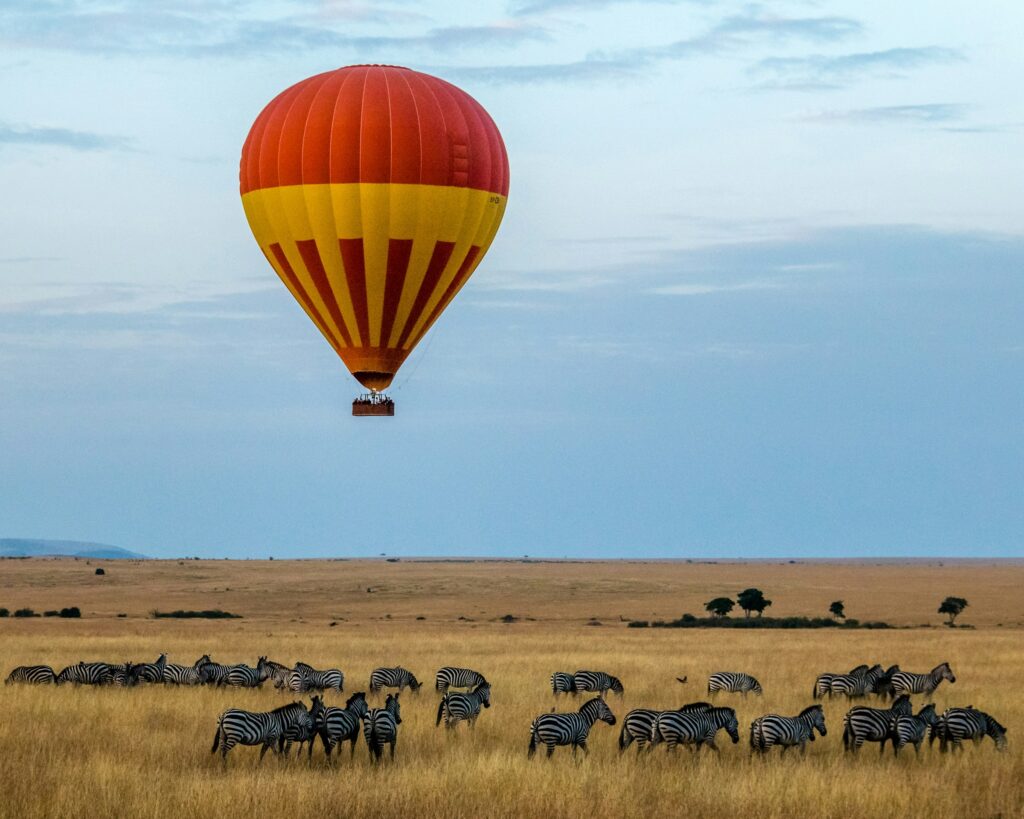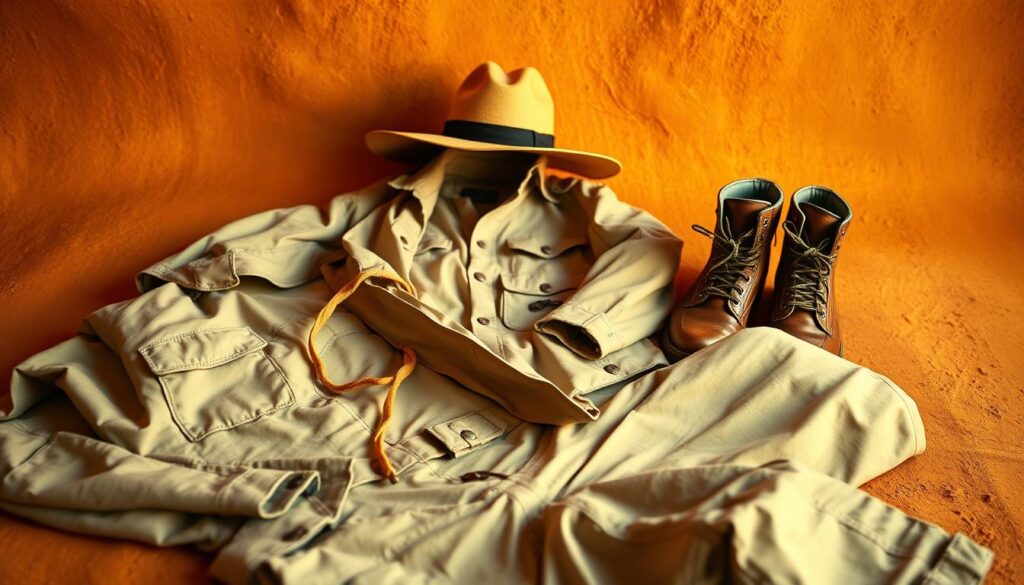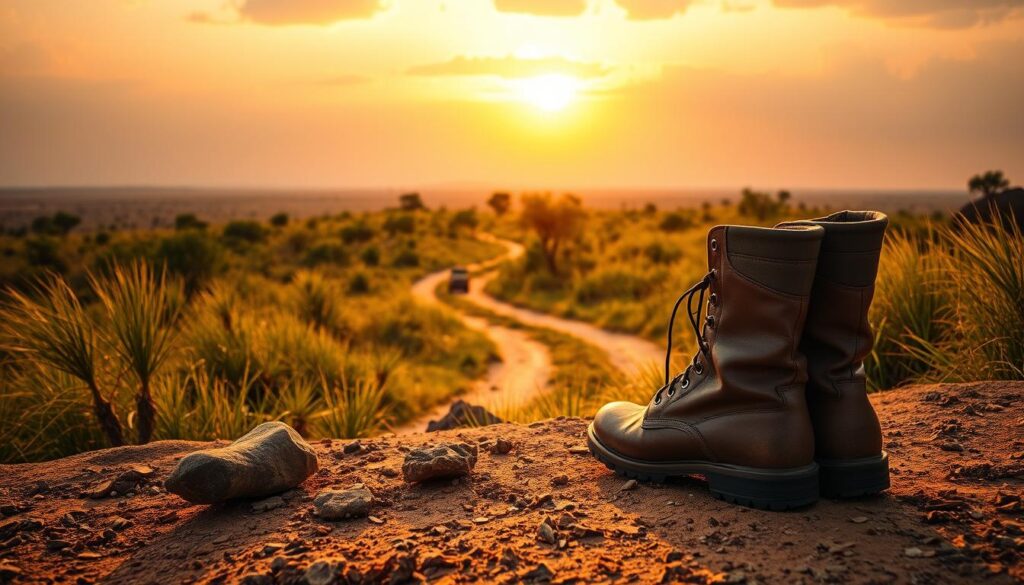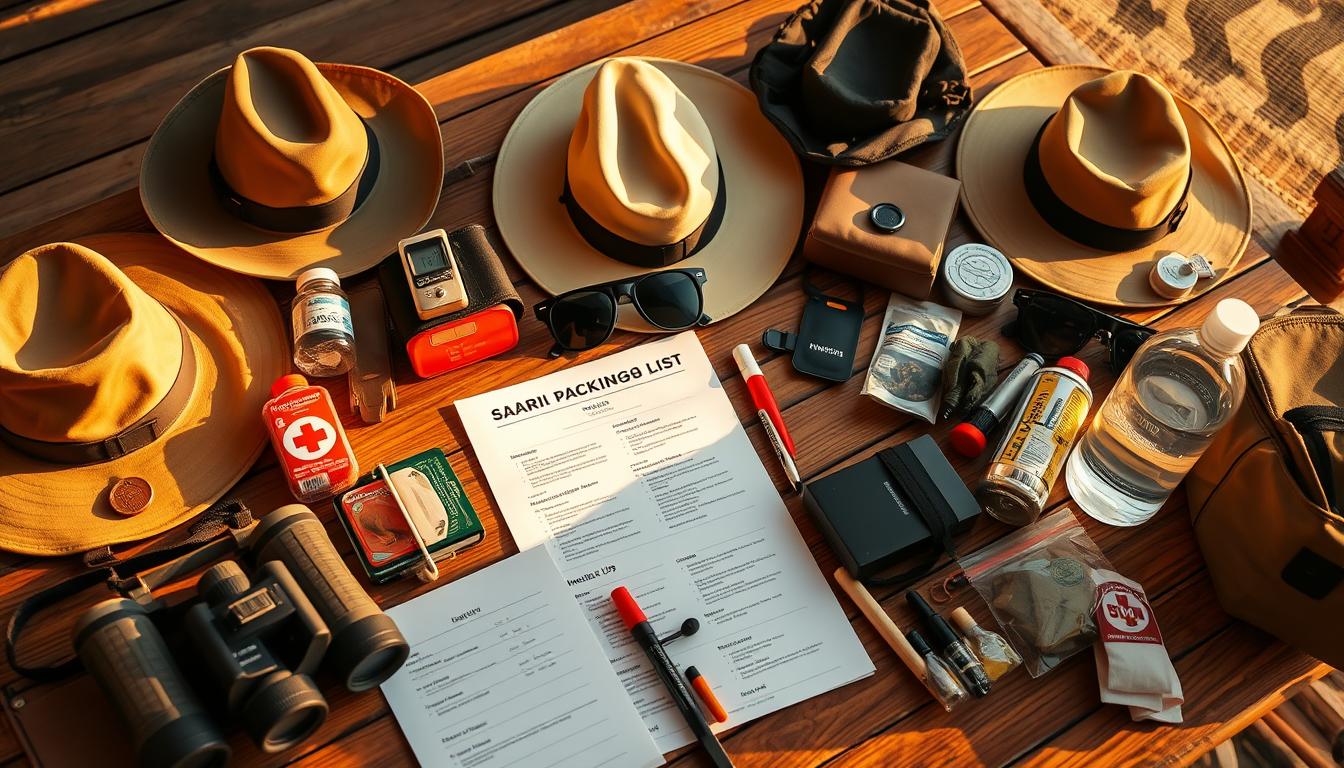Safari Packing List Essentials (Clothing, Medication, etc.)
Going on an African safari is an exciting journey that needs careful planning. With over 30 million people going on safaris every year, it’s getting more popular.
As I get ready for my trip, I must pack the right things for a good time. Being well-prepared is key to a great safari experience.
From clothes that keep me safe from the weather to medicine for my health, every item is important. In this article, I’ll share the essentials for what to pack for an african safari. This will help you get ready for your adventure.
Planning Your Safari in Africa: What to Know Before You Pack
To pack right for my African safari, I must learn about the climate, travel rules, and what to leave behind. This helps me choose wisely what to bring.
Understanding Safari Climate and Seasonal Variations
Africa’s climate changes a lot by region and season. The dry season, from May to October, is best for seeing wildlife. Animals gather near water then.
The wet season can make roads hard to travel and visibility poor. I need to know the weather at my destination to pack right.
Weight and Luggage Restrictions for Safari Travel
Safari travel has rules on weight and luggage size, mainly for light planes or safari camps. Usually, you can carry 15-20 kg (33-44 lbs) at most. But this can change.
It’s key to check with my tour or airline for their rules. This way, I avoid problems on my trip.

Essential Safari Clothing: The Layering Strategy
Choosing the right clothes for a safari is more than picking a few items. It’s about creating a layering system that’s versatile. This way, you can adjust your clothes as the temperature and activities change. It keeps you comfortable and practical during your luxury safari or safari adventure.
Neutral-Colored Clothing Options and Why They Matter
Wearing neutral-colored clothes is key for safaris. It helps you blend in with the environment, so you don’t scare the wildlife. Colors like beige, green, and brown are perfect. They also keep you cool by not reflecting sunlight.
Long-Sleeved Shirts and Pants for Sun and Insect Protection
Long-sleeved shirts and pants are vital for protecting your skin. They shield you from the sun and bugs. Choose lightweight, breathable fabrics that won’t make you too hot. Look for clothes with UPF protection to block UV rays.
Evening and Morning Layers for Temperature Fluctuations
Temperatures can change a lot during safaris, mainly in the mornings and evenings. Bringing layers like fleeces or light jackets keeps you warm. This layering strategy prepares you for any weather.

| Clothing Item | Purpose | Recommended Features |
|---|---|---|
| Neutral-colored clothing | Blend in with surroundings | Earth tones, breathable fabric |
| Long-sleeved shirts and pants | Sun and insect protection | UPF protection, lightweight |
| Evening and morning layers | Temperature regulation | Fleece, light jacket, breathable |
Footwear for Safari Adventures
The right shoes can make a big difference on a safari. They offer comfort and protection during game drives and walks in the bush. It’s key to pack shoes that fit the terrain and activities you plan.

Comfortable Walking Boots or Shoes for Game Drives and Bush Walks
Comfortable walking boots or shoes are a must for most safaris. They need to be sturdy for ankle support and to protect your feet from rough ground. Choose boots that are waterproof and have a good grip for different conditions.
Exploring the best safaris in Africa means you’ll need shoes that can handle your adventures.
Camp Sandals and Additional Footwear for Downtime
While sturdy boots are great for game drives and walks, camp sandals are better for downtime at the lodge or camp. They let your feet breathe and are a nice break after a long day. When looking at safari vacation deals, think about the footwear you’ll need for both adventure and rest.
For those into wildlife tours Africa, the right shoes can make your experience even better.
Safari Accessories That Make a Difference
As I get ready for my safari adventure in a best safari destination, I’m focusing on the right accessories. A luxury safari experience means being well-prepared with the best gear.
Wide-Brimmed Hats and Sun Protection Gear
A wide-brimmed hat is key for protecting my face, neck, and ears from the sun. I also bring sun protection items like sunscreen, lip balm, and UV-protected sunglasses.
Scarves and Bandanas for Dust and Sun Protection
Scarves and bandanas are great for a safari. They keep me dust-free during drives and add sun protection when worn around my neck or head.
Gloves and Warm Accessories for Early Morning Game Drives
Early morning and evening drives can be cold, even in Africa’s savannas. I bring gloves and warm items like a fleece jacket or hat to stay cozy.
| Accessory | Purpose | Benefit |
|---|---|---|
| Wide-Brimmed Hat | Sun Protection | Prevents sunburn and discomfort |
| Scarves/Bandanas | Dust and Sun Protection | Versatile and practical for various conditions |
| Gloves | Warmth | Keeps hands warm during early morning drives |
With these accessories, I’m all set for a guided safari tour that’s both comfortable and unforgettable.
Medical Kit and Medications for Your Safari in Africa
Going on an African safari means you need the right medical supplies. A good medical kit helps with minor problems and emergencies. It’s key to a safe and healthy trip.
Essential Prescription Medications and Documentation
If you have health issues, bring enough prescription medications for your trip and a little extra. Carry the original labels and a doctor’s letter. This is important for medical help during your safari.
Over-the-Counter Remedies for Common Safari Ailments
Your kit should also have over-the-counter remedies for common issues like headaches and allergies. Pack pain relievers, antacids, and antihistamines. These can help manage symptoms.
First Aid Supplies for Minor Injuries and Emergencies
A basic first aid kit has items for small injuries, like bandages and antiseptic wipes. Include snake bite kits or blister care if needed, based on your safari activities.
| Medical Supply | Purpose |
|---|---|
| Prescription medications | For pre-existing medical conditions |
| Over-the-counter remedies | For common ailments like headaches and diarrhea |
| First aid supplies | For minor injuries and emergencies |
With a well-prepared medical kit, your African safari will be safe and fun. Make sure to pack all necessary medications and supplies.
Safari Electronics and Camera Equipment
Capturing the essence of a wildlife safari needs the right gear. With so much wildlife and stunning landscapes, it’s a photographer’s dream.
Packing the right camera and accessories is key. You’ll need a good DSLR or mirrorless camera, various lenses, and a sturdy tripod for stable shots.
Camera Gear and Accessories for Wildlife Photography
A good camera is just the start. You’ll also need different lenses, like a telephoto for distant wildlife and a wide-angle for landscapes. Don’t forget filters, lens cleaning cloths, and extra batteries.
Binoculars for Enhanced Wildlife Viewing
Binoculars are vital for any safari. They let you see wildlife from far away without disturbing them. Choose waterproof binoculars with good optical quality.
Power Banks, Chargers, and Adapters for Remote Locations
With all the camera and binocular use, power can run low. Bring power banks, chargers, and adapters to stay charged, even in remote spots.
| Equipment | Description | Importance |
|---|---|---|
| DSLR/Mirrorless Camera | High-quality camera for capturing wildlife and landscapes | High |
| Telephoto Lens | Lens for capturing distant wildlife | High |
| Binoculars | For spotting wildlife from a distance | High |
| Power Banks | For keeping devices charged in remote locations | Medium |
Think about your safari type and activities when packing. This will help you choose the most important electronics and camera gear.
Essential Documents and Money Matters for Safari in Africa
Before you go on your African safari, get your documents ready and know about money matters. A traveler who is well-prepared can avoid problems and enjoy their trip more.
Passport, Visas, Vaccination Records, and Travel Insurance
Having the right documents is key. Your passport must be valid for at least six months after you leave Africa. You might need visas to enter some countries. Also, keep your vaccination records up to date, as some shots are needed for entry.
Travel insurance is a must. It covers medical issues, trip cancellations, and evacuations.
| Document | Description | Importance Level |
|---|---|---|
| Passport | Valid for at least six months beyond your departure date | High |
| Visas | Required for certain nationalities and destinations | High |
| Vaccination Records | Proof of required vaccinations | High |
| Travel Insurance | Covers medical emergencies, trip cancellations, and evacuations | High |
Currency, Credit Cards, and Payment Options on Safari
Knowing the local money and payment options is key for a good safari. Many places accept credit cards, but have local currency for small things and tips. Tell your bank you’re traveling to avoid card issues.
Being ready with documents and knowing about money lets you enjoy your safari. Whether planning your trip, booking packages, or looking for deals, being informed makes your experience better.
Toiletries and Personal Care Items
A well-stocked toiletry bag is key for staying clean on your safari. Think about the special needs of your trip, like not having easy access to some things.
Eco-Friendly and Biodegradable Toiletries for Safari
Choosing eco-friendly toiletries is good for the planet and often needed at safari places. Look for products without harsh chemicals and in recyclable packaging. Brands like Dr. Bronner’s and The Body Shop are great. Always check labels to make sure they fit your needs and the safari’s green standards.
| Product | Eco-Friendly Features | Benefits for Safari |
|---|---|---|
| Dr. Bronner’s Soap | Biodegradable, cruelty-free | Gentle on skin, environmentally safe |
| The Body Shop Toothpaste | Natural ingredients, recyclable packaging | Effective oral care, reduces plastic waste |
Sun Protection and Insect Repellent Essentials
It’s important to protect yourself from the sun and bugs on safari. Bring sunscreen with high SPF, lip balm, and after-sun lotion. For bug spray, choose DEET or picaridin. Repel Insect Repellent is a good choice for long-lasting protection. Remember to apply these often, after being outside.
Personal Hygiene in Remote Locations
Keeping clean in remote safari spots can be tough. Carry hand sanitizer and biodegradable wet wipes. For bigger needs, think about a portable shower or baby wipes. Also, bring a small stash of your usual hygiene items, as they might not be available where you are.
Safari Luggage: Choosing the Right Bags
The right luggage is key for a great safari experience. Whether you’re in luxury safari lodges or on guided tours, the luggage you pick matters. It keeps your stuff safe and easy to carry.
Soft-Sided Duffel Bags vs. Hard Cases for Different Safari Types
Most safaris prefer soft-sided duffel bags. They’re flexible and fit well in safari vehicles. But, for walking or camping safaris, hard cases protect fragile items better.
- Soft-Sided Duffel Bags: Great for most safaris, these bags are easy to carry and store.
- Hard Cases: Ideal for safaris with lots of walking or camping, they offer better protection for your gear.
Day Packs and Camera Bags for Game Drives
Day packs and camera bags are must-haves for game drives. They let you carry your camera, water, and more comfortably.
- Look for a day pack that’s light and has many compartments for organization.
- For camera gear, pick a bag with padded spots to keep your equipment safe.
Choosing the right luggage makes your safari better. It prepares you for the exciting adventures in Africa’s wildlife tours.
Comfort Items for Luxury Safari Lodges and Tented Camps
When you stay at luxury safari lodges and tented camps, adding comfort items to your packing list can really improve your experience. These comforts can make you feel more relaxed and refreshed during and after your safari.
To make sure you’re comfortable, think about a few important areas. First, let’s talk about sleep aids for unfamiliar places and night sounds.
Sleep Aids for Unfamiliar Environments and Night Sounds
Unfamiliar night sounds and places can sometimes keep you awake. To help with this, pack:
- Earplugs or earmuffs for better sleep
- An eye mask to block out light
- A portable white noise machine or a sleep app on your phone
These items can help you sleep better, so you’re ready for the next day’s adventures.
Entertainment and Downtime Activities Between Game Drives
Downtime between game drives is perfect for relaxing and having fun. Bring:
- A good book or e-reader
- A deck of cards or travel-sized games
- A journal to write about your experiences
These activities can make your downtime more enjoyable, adding to your luxury safari experience.
By adding these comfort items to your packing list, you can make your luxury safari experience even better. It will be an adventure you’ll never forget.
Eco-Friendly and Sustainable Safari Packing
Preparing for my African safari, I focus on eco-friendly packing. This makes my wildlife viewing more sustainable and responsible. I choose sustainable options for every item I pack.
Reusable Items to Reduce Environmental Impact
I’m packing reusable items to cut down on waste. These essentials include:
- Reusable water bottles to avoid single-use plastic bottles.
- Cloth bags for carrying things, reducing disposable bags.
- Beeswax wraps or reusable containers for snacks, no need for plastic wrap.
Responsible Wildlife Viewing Equipment and Practices
I’m also focusing on responsible wildlife viewing. This means:
- Using binoculars for a closer look without disturbing animals.
- Avoiding flash photography to not scare or disturb wildlife.
- Staying on paths and following guide instructions to protect the environment.
By using these eco-friendly and sustainable methods, I can enjoy my safari. I’ll also help protect the environment and wildlife.
Conclusion: Final Packing Tips for an Unforgettable Safari Experience
As I get ready for my safari adventure in Africa, I’ve learned packing the right gear is key. Following the tips in this article, I’ll be ready for the African safari challenges. I’ll make the most of my time in the wild.
To have a comfortable and fun safari in Africa, being prepared is vital. I’ve packed versatile, neutral-colored clothes and sturdy shoes. It’s also important to bring a wide-brimmed hat, sunscreen, and a first-aid kit. These items protect me from the elements and any injuries.
I’m excited to dive into Africa’s natural beauty on my safari adventure. With the right preparation, I’m sure my experience will be unforgettable.

